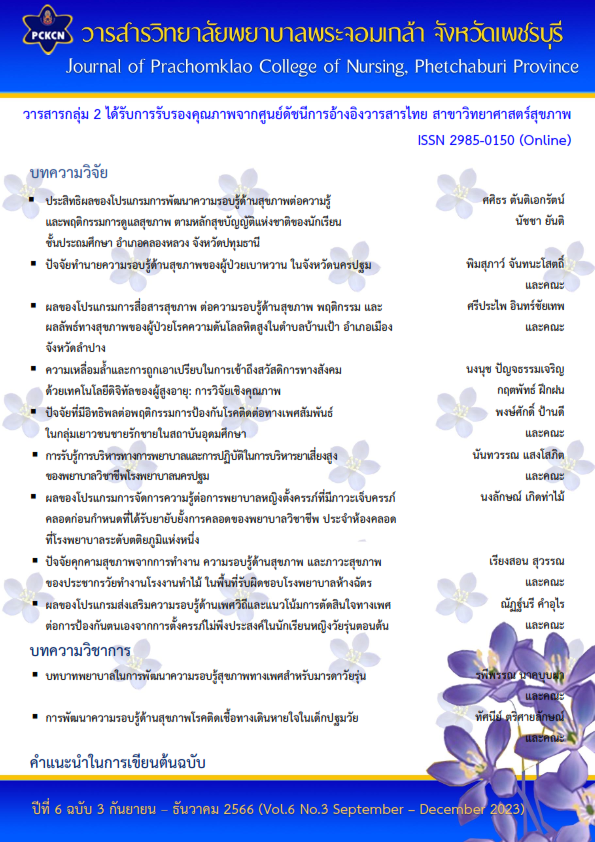ผลของโปรแกรมการสื่อสารสุขภาพ ต่อความรอบรู้ด้านสุขภาพ พฤติกรรมและผลลัพธ์ทางสุขภาพของผู้ป่วยโรคความดันโลหิตสูง ในตำบลบ้านเป้า อำเภอเมือง จังหวัดลำปาง
Main Article Content
บทคัดย่อ
การวิจัยกึ่งทดลอง มีวัตถุประสงค์เพื่อเปรียบเทียบความรอบรู้ด้านสุขภาพ พฤติกรรม และผลลัพธ์ทางสุขภาพของผู้ป่วยโรคความดันโลหิตสูง กลุ่มตัวอย่างคือผู้ป่วยโรคความดันโลหิตสูง จำนวน 59 คน แบ่งเป็นกลุ่มทดลองได้รับโปรแกรมการสื่อสารสุขภาพ จำนวน 29 คน และกลุ่มควบคุมได้รับสุขศึกษาตามแนวปฏิบัติเดิม จำนวน 30 คน เครื่องมือวิจัยได้แก่ โปรแกรมสื่อสารสุขภาพสำหรับผู้ป่วยโรคความดันโลหิตสูง แบบบันทึกข้อมูลสุขภาพ แบบประเมินความรอบรู้ด้านสุขภาพ และแบบประเมินพฤติกรรมสุขภาพ มีค่าความเชื่อมั่นสัมประสิทธิ์แอลฟาของครอนบาค เท่ากับ .82 และ .77 ตามลำดับ วิเคราะห์ข้อมูลด้วยสถิติเชิงพรรณนา การทดสอบวิลคอกซัน การทดสอบแมนท์-วิทนี ยู และการทดสอบไคสแควร์
ผลการวิจัยพบว่า ผู้ป่วยความดันโลหิตสูงภายหลังใช้โปรแกรมการสื่อสารสุขภาพ พบว่า มีคะแนนความรอบรู้ด้านสุขภาพ พฤติกรรมสุขภาพ ความดันโลหิตตัวบน และความดันโลหิตตัวล่าง แตกต่างกันจากก่อนการใช้อย่างมีนัยสำคัญทางสถิติที่ระดับ. 05 (Z = 3.16, 2.69, -2.46 และ -3.11 ตามลำดับ) ส่วนระดับดัชนีมวลกายไม่แตกต่างกัน (Z = .-1.00, p = .27) และเมื่อเปรียบเทียบกับกลุ่มที่ได้รับสุขศึกษาตามแนวปฏิบัติเดิม พบว่า มีคะแนนเฉลี่ยความรอบรู้ด้านสุขภาพ พฤติกรรมสุขภาพ และระดับความดันโลหิตตัวล่างแตกต่างกัน อย่างมีนัยสำคัญทางสถิติที่ระดับ .05 (Z = 3.25, 3.03 และ -2.02 ตามลำดับ) ส่วนค่าเฉลี่ยความดันโลหิตตัวบนและดัชนีมวลกาย ไม่แตกต่างกัน (Z = -1.86, -1.56; p =.11, .12 ตามลำดับ)
บุคลากรสุขภาพที่ดูแลผู้ป่วยความดันโลหิตสูงในหน่วยบริการปฐมภูมิ ควรนำโปรแกรมการสื่อสารสุขภาพไปใช้อย่างต่อเนื่อง และกำหนดนโยบายในการส่งเสริมความรอบรู้ด้านสุขภาพ ปรับเปลี่ยนแนวทางการให้สุขศึกษาให้เป็นการสื่อสารมุ่งเน้นการปรับเปลี่ยนพฤติกรรม ให้สอดคล้องกับปัจเจกบุคคล
Downloads
Article Details

อนุญาตภายใต้เงื่อนไข Creative Commons Attribution-NonCommercial-NoDerivatives 4.0 International License.
เนื้อหาและข้อมูลที่เผยแพร่ในวารสารวิทยาลัยพยาบาลพระจอมเกล้า จังหวัดเพชรบุรี ถือเป็นข้อคิดเห็นและความรับผิดชอบของผู้นิพนธ์บทความโดยตรง บทความ เนื้อหา ข้อมูล รูปภาพ ฯลฯ ที่ได้รับการเผยแพร่ในวารสารนี้ ถือเป็นลิขสิทธิ์ของวารสารฯ หากบุคคลหรือหน่วยงานใดต้องการนำทั้งหมดหรือส่วนหนึ่งส่วนใดไปเผยแพร่หรือเพื่อกระทำการใด ๆ จะต้องอ้างอิงวิทยาลัยพยาบาลพระจอมเกล้า จังหวัดเพชรบุรี ทุกครั้ง
เอกสารอ้างอิง
Ayoh, N., Sittisart, V., & Na Wichia, S. (2022). The effectiveness of health promoting program on behavior modification based on PBRI’s model for patients with hypertension in Samokhae Sub-district, Mueang District, Phitsanulok Province. The Journal of Boromarjonani College of Nursing, Suphanburi, 5(2), 129-139. (in Thai)
Burat, C., Sutta, O., & Ngamthuan, S. (2020). The results of the health literacy promotion program on the behavior of preventing high blood pressure among those at risk for high blood pressure, Ban Rai Khee, Rai Khee Subdistrict, Lue Amnat District, Amnat Charoen Province. Amnat Charoen Provincial Public Health Office. http://www.amno.moph.go.th/amno_new/files/1p16.pdf (in Thai)
Bureau of Non-Communicable Diseases, Department of Disease Control. (2018). Annual Report 2018. Graphic and Design Publishing House. (in Thai)
Cho, Y. I., Lee, S. Y. D., Arozullah, A. M., & Crittenden, K. S. (2008). Effects of health literacy on health status and health service utilization amongst the elderly. Social Science & Medicine, 66(8), 1809-1816.
Chomai, P., & Pranprawit, A. (2015). Study of the results of the health promotion program in changing health behavior of groups at risk for high blood pressure in Ban Khao Din Subdistrict Health Promoting Hospital, Khao Phanom District, Krabi Province. Pitchayathas Graduate School Journal, 10(1), 15-24. (in Thai)
Darvishpour, J., Omidi, S., & Farmanbar, R. (2016). The relationship between health literacy and hypertension treatment control and follow-up. Caspian Journal of Health Research, 2(1), 1-8.
De Schutter, A., Lavie, C. J., & Milani, R. V. (2014). The impact of obesity on risk factors and prevalence and prognosis of coronary heart disease—the obesity paradox. Progress in Cardiovascular Diseases, 56(4), 401-408.
Department of Health, Ministry of Public Health. (2018). Report on the results of the assessment of health literacy and health behavior 2018. Ministry of Public Health. (in Thai)
Du, S., Zhou, Y., Fu, C., Wang, Y., Du, X., & Xie, R. (2018). Health literacy and health outcomes in hypertension: An integrative review. International Journal of Nursing Ssciences, 5(3), 301-309.
Ekpalakorn, W. (2021). Survey of Thai people's health by physical examination, 2019-2020. Akson Graphic and Design. (in Thai)
Ferri, C., Ferri, L., & Desideri, G. (2017). Management of hypertension in the elderly and frail elderly. High Blood Pressure & Cardiovascular Prevention, 24, 1-11.
Health Data Center (HDC). (2023). Medical and health archives system. https://hdcservice.moph.go.th/hdc/main/index.php (in Thai)
Miller, S. J., Foran-Tuller, K., Ledergerber, J., & Jandorf, L. (2017). Motivational interviewing to improve health screening uptake: A systematic review. Patient Education and Counseling, 100(2), 190-198.
Nutbeam, D. (2008). The evolving concept of health literacy. Social Science & Medicine, 67(12), 2072-2078.
Phanphrom, P., Rodjakpai, Y., & Wirutsettasin, K. (2017).The results of the weight-control program on applying the concept of self-regulation towards body mass index of people who were overweight. Journal of Public Health Nursing, 31(1), 44-59. (in Thai)
Prayai, N., Kramanon, S., & Koomsiri, P. (2021). Motivational interviewing (MI): Review article. Thai Journal of Clinical Psychology, 52(1), 61-74. (in Thai)
Thongma, P. (2020). Health literacy and health outcomes in hypertensive patients. Thai Red Cross Nursing Journal, 13(1), 50-56 (in Thai)


